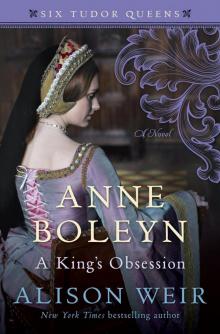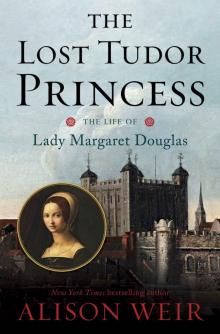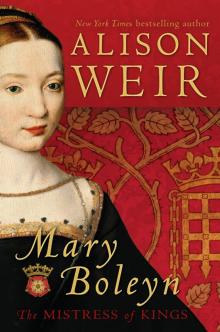- Home
- Alison Weir
Queen Isabella Page 8
Queen Isabella Read online
Page 8
Isabella remained at Langley when Edward traveled to Bristol with Piers to see him off on a ship bound for Dublin.98 On the day he sailed, 25 June, the King took his earldom of Cornwall into his own hands until such time as his beloved should return.99 During his time in office in Ireland, Gaveston proved an efficient and successful deputy. He suppressed two revolts, executed rebel chieftains, restored royal fortifications, and won the support of the Irish nobles through lavish gifts.100 Edward had given him blank royal charters to use as he saw fit,101 so he in effect wielded sovereign authority.
Once Gaveston had gone, the barons forced Edward to dismiss several officials from his household and Hugh le Despenser from his council, claiming that Despenser exercised an undesirable influence on the King.102
Bereft of Gaveston, Edward was plunged into misery, but over the next fourteen months, he used every persuasion to get his barons to agree to his return, bending “one after another to his will with gifts, promises and blandishments.”103 To begin with, he bought the loyalty of his nephew, Gloucester, with a large grant of land; then he set to work on the others, eventually reaching terms with Hereford and Lincoln. After that, most of the rest were willing to make terms.104
Isabella, meanwhile, had gone to Windsor, and Edward joined her there by 8 July. On the fourteenth, she left to go alone on a short pilgrimage to the shrine of Becket at Canterbury.105
Isabella was probably at Northampton when Parliament met there on 4 August. By now, Edward was enjoying better relations with his barons,106 and later that month, Isabella, doubtless dutifully acting on her husband’s orders, entertained some of them at a great feast at Westminster.107
In response to Edward’s letter of 16 June, King Philip sent his brother Evreux and Bishop Guy of Soissons to England in September; their brief was to help bring about a concord between Edward and his lords and thus improve Isabella’s situation.108 The King dined with Evreux on the twenty-first,109 and it is likely that they discussed Gaveston’s possible return and its consequences. Soon afterward, emissaries of the Pope arrived in England, also bent on securing a peace. By now, Edward was reconciled with most of his leading nobles, but he was still granting rich wardships to the absent Gaveston and at the end of October sent Roger Mortimer to assist him in Ireland.
By November, however, a rift was growing between the King and Thomas of Lancaster. The Earl ceased to witness royal charters, and the King’s patronage suddenly dried up.110 This suggests that a quarrel of some sort had taken place, possibly because Lancaster had divined that Edward was scheming for Gaveston’s return. Although it would be some months before Lancaster finally joined the barons in opposition, the loss of such a powerful supporter was to prove catastrophic to Edward. Much has been made by historians of Lancaster’s supposed sympathy for his niece Isabella, but there is in fact very little evidence to show that he was especially supportive of her.
Fortunately, Isabella was in better case than before, for with Gaveston out of the way, Edward began treating her with greater respect and allowed her to assume at last her rightful place as Queen of England. She now appeared constantly at her husband’s side and traveled everywhere with him. She also began to exercise the patronage that was her queenly prerogative; on 3 December, at Westminster, she granted one John de Peckbridge of Spalding, Lincolnshire, and all the men of Spalding, exemption from paying tolls.111 At this time, the King made lavish grants of money to her and gave her manors in England and Wales, along with the right to appoint priests and clerks to benefices.112
The King and Queen spent Christmas at Windsor “with great solemnity.” Isabella was now making a point of dutifully supporting her husband, which suggests that, with Gaveston gone, relations between them were kinder. In her innocence, Isabella may have believed that the favorite was gone for good. At the beginning of March, she made a point of dining with Richmond, Gloucester, and other royalist earls at Westminster,113 possibly with a view to binding them closer in loyalty to the King.
In March and April, to show his gratitude, and doubtless sweeten his wife and her father in preparation for Gaveston’s recall, Edward bestowed further grants and privileges on Isabella; among them were the manors of Macclesfield, Rhosfeir, Dolpennagen, and Peneham, and the Welsh commote114 of Menai. These grants were backdated to the previous September.115 On 4 March, the King ordered the immediate payment of all the Queen’s gold—a percentage on payments made to the King—due to Isabella since her marriage.116 In April, Isabella was also given the reversion of the manor of Ellesmere.117
Later in March, Edward wrote to the Pope, informing him, with false optimism, that the barons were now ready to agree to Gaveston’s return,118 he himself having promised to agree to certain administrative reforms. Edward was also going out of his way to win King Philip’s support, dealing harshly with the Templars in his realm and showing himself most accommodating in disputes concerning Gascony.119
Philip, that shrewd man, was not to be moved. On 13 April, he was still opposing Gaveston’s return,120 but even so, Edward, increasingly desperate and as thick-skinned as ever, still had the nerve to ask his father-in-law outright to intercede with the lords on Gaveston’s behalf.121 Philip was understandably unwilling, but the Pope proved more accommodating. On 25 April, he issued a bull of absolution, quashing Archbishop Winchelsey’s threat of excommunication and paving the way for Gaveston’s sentence of banishment to be lifted.
But Edward had been mistaken in thinking that his barons were ready to agree to the favorite’s return. When Parliament met at Westminster on 27 April, it refused his request outright. Isabella, who was in residence at Westminster at the time, must have been relieved to hear this.122 But the King was biding his time, and as he and Isabella removed to Kennington Palace, south of the Thames, for further talks with his barons,123 he was only waiting for the Pope’s response to his plea. It arrived in June, and then he had the satisfaction of reading it aloud before a disconcerted and tight-lipped Winchelsey, who was painfully aware that he had been bested.
On 19 June, Edward, still naively hoping that Philip IV would act as mediator in his quarrel with the barons, requested a meeting with the French King.124 By then, however, he had already summoned Gaveston home. Piers left Ireland around 23 June, and Edward, “rejoicing at his return,” welcomed him at Chester on the twenty-seventh, “very thankfully receiving him with honour as his brother.”125 Isabella was conspicuous by her absence.
The King was “overjoyed at Piers’s presence and, as one who receives a friend returning from a long pilgrimage, passed pleasant days with him.”126 The Queen’s reaction is not recorded but may be guessed at.
A month later, King and favorite faced Parliament at Stamford, where, thanks to the intervention of the Pope and the conciliatory efforts of Gloucester, whose sister was married to Piers, the barons grudgingly gave their formal assent to Gaveston’s return; only Warwick and Archbishop Winchelsey objected. “None of the barons now dared to raise a finger against Piers, or to lay any complaint about his return. Their ranks wavered and their party, divided against itself, broke up. So he who had twice been condemned to exile returned, exulting and in state.”127
On 5 August, the earldom of Cornwall was restored to Gaveston, and on 4 September, a grateful Edward wrote to thank the Pope for his assistance.128 Now that he no longer needed King Philip’s support, he had abandoned all plans for a meeting; and since Edward was continuing to treat Isabella with respect and generosity and to uphold her royal privileges,129 Philip did not immediately choose to intervene, even though neither he nor his daughter welcomed the favorite’s return.
Edward’s tenacious efforts to win over and outwit his barons had borne fruit, but Gaveston’s own behavior meant that this uneasy truce did not last.130 Rashly, the King allowed him once more to control the flow of patronage; but this time, Piers did not bother to hide his contempt for those who had opposed him or his triumph at the victory he had scored over his opponents. “Now that he had regained his former
status, his behaviour was worse than before.”131 Despite having promised Parliament that he would conduct himself circumspectly and live at peace, he “remained a man of big ideas, haughty and puffed up. Scornfully, rolling his upraised eyes in pride and abuse, he looked down upon all with pompous and supercilious countenance, which would have been unbearable enough in a king’s son.”132
He particularly provoked the barons by openly calling them by offensive and “degrading names.”133 The portly Lincoln was “Burstbelly”; Lancaster was the “Churl,” the “Old Hog,” “the Player,” or “the Fiddler”; Warwick was the “Black Dog of Arden”—“Does he call me a dog?” retorted Warwick. “Let him take care lest I bite!”134 The sallow-skinned Pembroke was “Joseph the Jew,” and even Gloucester, who had been a friend to Gaveston, was called “Cuckold’s Bird” and “Whoreson,” both insulting allusions to his mother, the late Joan of Acre, who had defied Edward I and taken a second husband for love, despite his lowly birth. Even Queen Isabella herself was not exempted from Gaveston’s sarcasm,135 although we do not know what form it took. Such disrespect enraged the barons, even the moderate Pembroke.136 And when Gaveston high-handedly made the King dismiss one of Lancaster’s retainers in favor of one of his own, he finally drove the furious Earl wholeheartedly into the arms of the opposition, vowing that he would destroy the favorite.137
The barons now accused Gaveston of filling the court with his foreign relatives and greedily appropriating the revenues of the kingdom to such an extent that the King could not meet the charges of his court. As a result, it was claimed, the Queen was subjected to unworthy reductions in her income and was provoked once more into complaining to her father.138
By October, baronial hostility to Gaveston was once again simmering dangerously, and for safety, the King took him and Isabella to York. When visiting the city, Edward I had stayed in York Castle, first raised by William the Conqueror and rebuilt in 1244–45 by Henry III with an unusual quatrefoil-shaped keep known as Clifford’s Tower. However, whenever Edward II and Isabella visited York, they usually lodged in the Franciscan Priory of the Friars Minor, founded in 1232 and relocated in 1243 to a site between Castlegate and the River Ouse. Here there were spacious apartments for visitors and gardens that stretched as far as the outworks that encircled the nearby Clifford’s Tower.139
While in York, Edward summoned Parliament to meet there on 18 October, but Lancaster, Arundel, Hereford, Oxford, and Warwick categorically refused to attend because of Gaveston’s presence at the King’s side.140 Edward postponed the session and issued new summonses to Westminster for 8 February.
In November, concerned at the prospect of civil war in England, and also no doubt provoked by his daughter’s complaints, King Philip sent Evreux once more to England, to act as mediator between Edward and his barons.
The King, Isabella, and Gaveston left York on 17 November and journeyed southward.141 In December, in order to forestall his opponents, Edward ordered that scandalmongers be arrested and forbade any armed gatherings of the barons.142 He spent Christmas at Langley with the Queen and Gaveston. Isabella’s stay at Langley cannot have been a happy one, for she seems to have been largely ignored, while her husband and Gaveston spent their time “fully making up for earlier absence by their daily sessions of intimate conversation.”143
When Parliament met in February 1310, its mood was ugly—the barons appeared once more in arms, in defiance of the King—so Edward sent Gaveston back north for safety,144 while he and Isabella remained at Westminster.145
The King was now in a weak position, and he knew it. Parliament’s condemnation of his rule was shattering.146 He was accused of corruption and extortion, heeding evil counsel, losing Scotland, and dismembering the Crown without the lords’ assent, this last being a direct reference to Gaveston, whom the barons described as “their chief enemy, who was lurking in the King’s chamber.”147 But there was worse to come: on 16 March, the barons demanded that he agree to the appointment of a controlling committee comprised of twenty-one “Lords Ordainers,” whose brief would be the drawing up of Ordinances, or regulations, for the reform of abuses within the government and the royal household; their real agenda, however—and Edward was well aware of this—was the undermining of the royal prerogative and the placing of restraints upon the King.
Edward protested strongly, but the barons held firm, telling him that unless he cooperated, “they would no longer hold him as their King, nor keep the fealty they had sworn to him, since he himself would not keep the oath which he had sworn at his coronation.” Edward had no choice but to capitulate.148
The names of the Ordainers were announced the next day in the Painted Chamber: foremost among the hard-liners were Warwick, Hereford, Arundel, Lancaster, and Archbishop Winchelsey, yet the moderates Pembroke, Lincoln, Surrey, and Gloucester were also of their number, and even the royalist Richmond.149 Within forty-eight hours, these lords had issued six preliminary Ordinances regulating taxation and customs dues.
By the end of April, Edward was trying desperately to reassert his authority and undermine the Ordainers. Gaveston returned to his side before 11 May,150 and in June, Edward began seeking the support of Surrey, Richmond, and Gloucester.151 That month, to sweeten the barons, who were grieved that he had not seized the initiative three years earlier when the chances of success were greater, he announced his intention of leading a campaign against the Scots. His real motive for going north, however, was the establishment of his court away from Westminster, where the Ordainers now held sway. Significantly, on 6 July, he appointed his loyal supporter, Walter Reynolds, who was not an Ordainer, to the office of Chancellor; Reynolds, he informed the Pope, was “not only useful, but indispensable”;152 thus, the King was able to resume control of the Great Seal, the prime instrument through which he could wield executive power.153
Isabella was at Westminster with Edward when, in July, he formally accepted the preliminary Ordinances. That month, Gaveston again went north, this time to prepare for the Scottish campaign.154 During the next four months, Edward unheedingly made a series of further grants to Piers.155 But he also continued to make grants to Isabella throughout 1310 and 1311, in the form of writs and warrants issued under the Privy Seal through the Royal Wardrobe.
The Queen was to go north with the King; she left London at the beginning of August and traveled in slow stages via Nottingham and Beverley.156 Edward himself, having appointed Lincoln Keeper of the Realm,157 followed in September and on the eighteenth was reunited with Gaveston at Berwick,158 whence the English army marched into Scotland. Yet it was an army largely without baronial support, for although all the earls had been summoned to attend the King, only Gloucester, Richmond, and Surrey showed up; the rest stayed at home “because they hated Gaveston more than the others.”159 Furthermore, the campaign proved a humiliating failure, for Bruce had laid waste the Scottish Lowlands, destroying crops and moving livestock north. Faced with starvation, the English were forced to retreat.160
By the beginning of November, Edward and Piers were back at Berwick, where Isabella joined them before the sixteenth.161 The King and Queen decided to winter at Berwick and actually stayed there until the following July. Gaveston went to Roxburgh in November and joined them later on.162 After Christmas, Gaveston surrendered a rich wardship, that of Thomas Wake, which he had been granted in October 1308, to Isabella.163 This must be interpreted as a conciliatory gesture toward the Queen; Gaveston was now constantly in her company and needed her goodwill, so it was imperative that relations between them be as cordial as possible. Edward would also have wished King Philip to know of Piers’s generosity toward Isabella.
In February 1311, there was bad news from London. The well-respected Lincoln had died on the fifth at his house, Lincoln’s Inn, in Holborn.164 His death removed the last moderate influence on the chief Ordainers. It also made his son-in-law, Lancaster, the richest and most powerful of the magnates, for Lancaster now inherited two more earldoms, those of Lincoln and Sal
isbury. However, when the Earl went north to pay homage to the King for them, he humiliated Edward by forcing him to cross the River Tweed to come to him, rather than cross it himself, as courtesy demanded, and then pointedly ignored Gaveston.165
Lancaster typified the “over-mighty subject” of the Middle Ages; his mission now was to become a second Simon de Montfort,166 ostensibly to save the country from misgovernment, but the chief aim of this grasping and ambitious aristocrat was to control the King; there was little political integrity or foresight in him. This was the man who emerged as the natural leader of the Ordainers, by virtue of his birth and wealth alone, and who would soon be Edward’s most dangerous enemy.
Gloucester was appointed Keeper of the Realm in Lincoln’s place.167 At this time, the King was experiencing increasing financial difficulties; he had even pledged the crown jewels as security against a loan.168 He had also lost support and credibility as a result of the humiliating Scottish fiasco; a further campaign, led by Gaveston in May and June 1311, was equally unsuccessful.169
This all played right into the hands of the Ordainers, who had nearly completed work on their proposed reforms and who now required the King’s presence in the capital. Reluctantly, on 16 June, Edward summoned Parliament to London,170 and at the end of July, he left Berwick with Isabella, having appointed Gaveston his Lieutenant in Scotland.171 After Edward had gone, however, Piers was unable to make any inroads against the enemy, and after a series of savage Scottish raids into the north of England, withdrew to Bamburgh in Northumberland.
Meanwhile, the Lords Ordainers had drawn up their full list of forty-one Ordinances,172 and on 3 August, a copy was sent to the King for inspection. To his utter dismay, he could see that the Ordainers meant to limit his power severely: he was not allowed to grant land, go to war, or even leave the realm without the consent of the barons in Parliament; his bankers, the Frescobaldi, were banished—and ruined—and his financial privileges curtailed. He was to “live more wisely and avoid oppression of the people.” “The King must not…; the King must not….” The list of prohibitions went on and on. This was all shocking enough; but Edward was far more distressed by Ordinance 20,173 which demanded that, because Piers Gaveston had “misled and ill-advised our Lord the King, and enticed him to do evil in various deceitful ways,” he be exiled “for all time and without hope of return” as “a public enemy of the King and his people.”

 Richard III and the Princes in the Tower
Richard III and the Princes in the Tower Britain's Royal Families: The Complete Genealogy
Britain's Royal Families: The Complete Genealogy The Lady in the Tower: The Fall of Anne Boleyn
The Lady in the Tower: The Fall of Anne Boleyn Six Wives of Henry VIII
Six Wives of Henry VIII Elizabeth of York: A Tudor Queen and Her World
Elizabeth of York: A Tudor Queen and Her World Captive Queen
Captive Queen Innocent Traitor
Innocent Traitor The Marriage Game
The Marriage Game A Dangerous Inheritance
A Dangerous Inheritance Katherine of Aragón: The True Queen
Katherine of Aragón: The True Queen The Marriage Game: A Novel of Queen Elizabeth I
The Marriage Game: A Novel of Queen Elizabeth I Princes in the Tower
Princes in the Tower Anne Boleyn: A King's Obsession
Anne Boleyn: A King's Obsession Traitors of the Tower
Traitors of the Tower Mistress of the Monarchy: The Life of Katherine Swynford, Duchess of Lancaster
Mistress of the Monarchy: The Life of Katherine Swynford, Duchess of Lancaster Queens of the Conquest: England’s Medieval Queens
Queens of the Conquest: England’s Medieval Queens Eleanor of Aquitaine: A Life
Eleanor of Aquitaine: A Life Mary, Queen of Scots, and the Murder of Lord Darnley
Mary, Queen of Scots, and the Murder of Lord Darnley Henry VIII: The King and His Court
Henry VIII: The King and His Court Queen Isabella: Treachery, Adultery, and Murder in Medieval England
Queen Isabella: Treachery, Adultery, and Murder in Medieval England Katheryn Howard, the Scandalous Queen
Katheryn Howard, the Scandalous Queen Arthur- Prince of the Roses
Arthur- Prince of the Roses The Wars of the Roses
The Wars of the Roses Eleanor of Aquitaine: By the Wrath of God, Queen of England
Eleanor of Aquitaine: By the Wrath of God, Queen of England Mary Boleyn: The Great and Infamous Whore
Mary Boleyn: The Great and Infamous Whore Jane Seymour: The Haunted Queen
Jane Seymour: The Haunted Queen Anna of Kleve, the Princess in the Portrait
Anna of Kleve, the Princess in the Portrait Lancaster and York: The Wars of the Roses
Lancaster and York: The Wars of the Roses The Grandmother's Tale
The Grandmother's Tale The Princess of Scotland (Six Tudor Queens #5.5)
The Princess of Scotland (Six Tudor Queens #5.5) The Lady Elizabeth
The Lady Elizabeth Katherine Swynford: The Story of John of Gaunt and His Scandalous Duchess
Katherine Swynford: The Story of John of Gaunt and His Scandalous Duchess The Curse of the Hungerfords
The Curse of the Hungerfords The Lost Tudor Princess: The Life of Lady Margaret Douglas
The Lost Tudor Princess: The Life of Lady Margaret Douglas Eleanor of Aquitaine
Eleanor of Aquitaine Mistress of the Monarchy
Mistress of the Monarchy The Lost Tudor Princess
The Lost Tudor Princess Henry VIII
Henry VIII Anne Boleyn, a King's Obsession
Anne Boleyn, a King's Obsession A Dangerous Inheritance: A Novel of Tudor Rivals and the Secret of the Tower
A Dangerous Inheritance: A Novel of Tudor Rivals and the Secret of the Tower Elizabeth of York
Elizabeth of York Katherine of Aragon, the True Queen
Katherine of Aragon, the True Queen Katherine Swynford
Katherine Swynford Wars of the Roses
Wars of the Roses Queens of the Conquest
Queens of the Conquest Mary Boleyn
Mary Boleyn Britain's Royal Families
Britain's Royal Families The Tower Is Full of Ghosts Today
The Tower Is Full of Ghosts Today Life of Elizabeth I
Life of Elizabeth I Anne Boleyn A King's Obssession
Anne Boleyn A King's Obssession Lancaster and York
Lancaster and York Jane Seymour, the Haunted Queen
Jane Seymour, the Haunted Queen Queen Isabella
Queen Isabella The princes in the tower
The princes in the tower